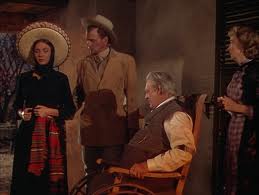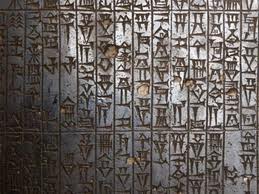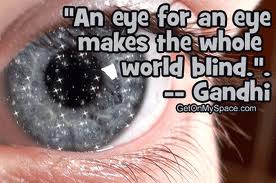An Eye for an Eye
 Monday, March 12, 2012 at 6:00AM
Monday, March 12, 2012 at 6:00AM  I was reminded recently of an old movie from 1946, Duel in The Sun. They spent an unheard of $5 million dollars on it. The wags called it Lust in the Dust. It is the story of a wealthy Cattle Baron and his two sons, one good (Joseph Cotton) and one bad (Gregory Peck), and the half-breed woman they both loved (Jennifer Jones). I do not remember the exact details, but one scene was burned into my mind. Lionel Barrymore (the evil banker in It’s A Wonderful Life), who played the wealthy father, sits in his wheelchair (Barrymore used one in real life), and shouts, “An eye for an eye and a tooth for a tooth.” He almost foams at the mouth as he says it. Barrymore was often over the top in his acting, but it worked in this scene. We all know people like that.
I was reminded recently of an old movie from 1946, Duel in The Sun. They spent an unheard of $5 million dollars on it. The wags called it Lust in the Dust. It is the story of a wealthy Cattle Baron and his two sons, one good (Joseph Cotton) and one bad (Gregory Peck), and the half-breed woman they both loved (Jennifer Jones). I do not remember the exact details, but one scene was burned into my mind. Lionel Barrymore (the evil banker in It’s A Wonderful Life), who played the wealthy father, sits in his wheelchair (Barrymore used one in real life), and shouts, “An eye for an eye and a tooth for a tooth.” He almost foams at the mouth as he says it. Barrymore was often over the top in his acting, but it worked in this scene. We all know people like that.
 Of course this attitude destroys his family.
Of course this attitude destroys his family.
The assumption of Barrymore, and the viewer, is that this attitude is based on the Bible. Nothing could be further from the truth. Here is the relevant section from Exodus 21:
But if there is serious injury, you are to take life for life, 24 eye for eye, tooth for tooth, hand for hand, foot for foot, 25 burn for burn, wound for wound, bruise for bruise.
The assumption is that this verse means that if I damage your eye, I will have the judges damage my eye in compensation. This is shocking to modern sensibilities. Is this what it really means?
An interesting place to look to answer this question is Hammurabi’s Code from roughly the same time as Biblical law.
196. If a man put out the eye of another man, his eye shall be put out.
197. If he break another man’s bone, his bone shall be broken.
198. If he put out the eye of a freed man, or break the bone of a freed man, he shall pay one gold mina.
199. If he put out the eye of a man’s slave, or break the bone of a man’s slave, he shall pay one-half of its value.
200. If a man knock out the teeth of his equal, his teeth shall be knocked out.
201. If he knock out the teeth of a freed man, he shall pay one-third of a gold mina.
 Note that the compensation is based on the status of the victim. If you hurt a noble, the noble can exact payment in similar damages to the perpetrator. But if the victim is a free person or a slave the compensation is different. I think most of us who are hurt in this way would much rather receive monetary compensation instead of exacting such punishment There is very little of class distinction in the Biblical law. The only example I can think of is that if a master hurts his slave, the slave receives no compensation, but the slave’s compensation is the slave’s freedom—not so in Hammurabi’s law. The master receives the compensation, and if the master does the damage, he does not have to pay anything. The basic point is that in Hammurabi’s Law the compensation was to be monetary unless the person you hurt was powerful.
Note that the compensation is based on the status of the victim. If you hurt a noble, the noble can exact payment in similar damages to the perpetrator. But if the victim is a free person or a slave the compensation is different. I think most of us who are hurt in this way would much rather receive monetary compensation instead of exacting such punishment There is very little of class distinction in the Biblical law. The only example I can think of is that if a master hurts his slave, the slave receives no compensation, but the slave’s compensation is the slave’s freedom—not so in Hammurabi’s law. The master receives the compensation, and if the master does the damage, he does not have to pay anything. The basic point is that in Hammurabi’s Law the compensation was to be monetary unless the person you hurt was powerful.
The law we Westerners are familiar with is that we are all equal before the law. (I would argue that this is not true in modern America). Biblical law is where this idea came from, here in Leviticus 24:
22 You are to have the same law for the foreigner and the native-born.
or Leviticus 19:
15 ”Don’t pervert justice. Don’t show favoritism to either the poor or the great. Judge on the basis of what is right.
or Exodus 23
2 ”Do not follow the crowd in doing wrong. When you give testimony in a lawsuit, do not pervert justice by siding with the crowd, 3 and do not show favoritism to a poor person in a lawsuit.
How then should one interpret “an eye for an eye”? It seems that as in Hammurabi’s Code, what is in mind here is monetary compensation. In other words, the phrase “eye for an eye” is idiomatic.
If I could be so bold as to quote myself, here is what I said on this issue many years ago:
 An example of this is the Rabbinical argument about the meaning of Exodus 21:24—an eye for an eye and a tooth for a tooth. The Rabbis were not comfortable with this at all. Jesus in Matthew 5 was not comfortable with the literal interpretation either. The Rabbis would then use Leviticus 24:22: ‘‘You shall have one manner of Law.’’ They would then discuss the case of the one-eyed man who put out the eye of a man who had two eyes. Was it fair to put out his only eye in order to achieve the “required” punishment of “an eye for an eye”? This would leave him blind. His victim was not blind. Was that justice? The Rabbis then concluded that Exodus 21:24 meant that a monetary fine was to be paid. To use modern terminology, they decided that the eye for an eye statement was idiomatic and meant let the punishment (money), fit the crime. They did not say that Exodus was wrong, only that “an eye for an eye” can only be understood in light of Leviticus 24:22.1
An example of this is the Rabbinical argument about the meaning of Exodus 21:24—an eye for an eye and a tooth for a tooth. The Rabbis were not comfortable with this at all. Jesus in Matthew 5 was not comfortable with the literal interpretation either. The Rabbis would then use Leviticus 24:22: ‘‘You shall have one manner of Law.’’ They would then discuss the case of the one-eyed man who put out the eye of a man who had two eyes. Was it fair to put out his only eye in order to achieve the “required” punishment of “an eye for an eye”? This would leave him blind. His victim was not blind. Was that justice? The Rabbis then concluded that Exodus 21:24 meant that a monetary fine was to be paid. To use modern terminology, they decided that the eye for an eye statement was idiomatic and meant let the punishment (money), fit the crime. They did not say that Exodus was wrong, only that “an eye for an eye” can only be understood in light of Leviticus 24:22.1
Note that this was the majority opinion at the time of Jesus. The Sadducees disagreed, and modern Sadducees, the Karaites, disagree as well.
Maimonides, the greatest Rabbi who ever lived, had this to say in Hilkhot Hovel uMazik 1, 3-6:
The text: “as he maimed a man, so shall it be rendered him” (Lev. 24:20) does not mean the literal inflicting of the identical maiming on the guilty person, but merely that though the latter deserves such maiming, he pays the monetary equivalent. For we are told: You shall take no ransom for the life of a murderer, implying that ransom is ruled out only in the case of a murderer, but is indicated in the case of one who maims another…
Here is quote from an article that discusses this issue from a Jewish perspective:
Benno Jacob also goes to this chapter for additional proof, citing the subject arrangement of the verses 18-22. They all deal with bodily harm, and are divided into two sections, the first of which is further subdivided as follows:
- 1. Bodily harm inflicted by man on his fellow:
- 1. Deliberate: 18-19 (re slave: 20-21)
- 2. Inadvertent: 22-25 (re slave: 26-27)
- 2. Bodily harm inflicted by the ox of another: 28-31 (re slave: 32).
 Not all Talmud, all the time for these boys. Now where is “eye for eye” or “tooth for tooth” mentioned in the text? Surely in connection with inadvertent action, whereas in the case of deliberate maiming, we are explicitly told (v. 19) that only loss of time and medical care has to be paid for. Were “eye for eye” to be taken literally, the penalty for inadvertent maiming would be greater than that for deliberate one.
Not all Talmud, all the time for these boys. Now where is “eye for eye” or “tooth for tooth” mentioned in the text? Surely in connection with inadvertent action, whereas in the case of deliberate maiming, we are explicitly told (v. 19) that only loss of time and medical care has to be paid for. Were “eye for eye” to be taken literally, the penalty for inadvertent maiming would be greater than that for deliberate one.
Monetary compensation appropriate to the level of damage done is what the phrase “an eye for an eye” means.
So now that we have a better understanding what the phrase “an eye for an eye” means, we can go to what Jesus said in Matthew 5:
38 You have heard that it was said, ‘Eye for eye, and tooth for tooth.’ 39 But I tell you, do not resist an evil person. If anyone slaps you on the right cheek, turn to them the other cheek also. 40 And if anyone wants to sue you and take your shirt, hand over your coat as well. 41 If anyone forces you to go one mile, go with them two miles. 42 Give to the one who asks you, and do not turn away from the one who wants to borrow from you.
Jesus is not disagreeing with the Old Testament, he is interpreting it properly. While one might have the right to monetary compensation, there is no reason to extract the last penny from your enemy. In fact Exodus 23 tells us how to treat our enemies.
4 ”If you come across your enemy’s ox or donkey wandering off, be sure to return it. 5 If you see the donkey of someone who hates you fallen down under its load, do not leave it there; be sure you help them with it.
 I remember a time when this scripture came to my mind. I was driving on my ranch and noticed a man stuck in a ditch on my property. I was immediately angry. If you wonder why, understand that it is difficult to hay your land if it is covered in ruts. The man was a trespasser! I am sure I chuckled to myself as I drove off. Then this verse overwhelmed me. I got a chain, and went back and pulled him out. We did not become best buddies, but I never looked at him in that negative way again.
I remember a time when this scripture came to my mind. I was driving on my ranch and noticed a man stuck in a ditch on my property. I was immediately angry. If you wonder why, understand that it is difficult to hay your land if it is covered in ruts. The man was a trespasser! I am sure I chuckled to myself as I drove off. Then this verse overwhelmed me. I got a chain, and went back and pulled him out. We did not become best buddies, but I never looked at him in that negative way again.
How can I be sure that the interpretation that is often advanced that Jesus is against the law is wrong? Jesus tells us so just a few verses earlier in Matthew 5 (Here from The Message version)
 17-18”Don’t suppose for a minute that I have come to demolish the Scriptures— either God’s Law or the Prophets. I’m not here to demolish but to complete. I am going to put it all together, pull it all together in a vast panorama. God’s Law is more real and lasting than the stars in the sky and the ground at your feet. Long after stars burn out and earth wears out, God’s Law will be alive and working.
17-18”Don’t suppose for a minute that I have come to demolish the Scriptures— either God’s Law or the Prophets. I’m not here to demolish but to complete. I am going to put it all together, pull it all together in a vast panorama. God’s Law is more real and lasting than the stars in the sky and the ground at your feet. Long after stars burn out and earth wears out, God’s Law will be alive and working.
19-20”Trivialize even the smallest item in God’s Law and you will only have trivialized yourself. But take it seriously, show the way for others, and you will find honor in the kingdom. Unless you do far better than the Pharisees in the matters of right living, you won’t know the first thing about entering the kingdom.
As the Psalmist said, the Law truly is a lamp unto our feet.
[1] A. Cohen, Everyman’s Talmud, (New York: Schocken, 1975), 327.
 Bible
Bible 
Reader Comments